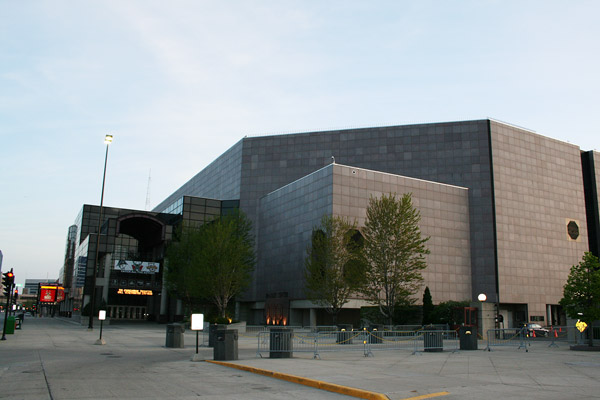
compujeramey/CC by 2.0
Bradley Center, Milwaukee
Public funding for private stadiums is a fact of life in any city. Chicago has dealt with it. Our neighbors to the north, in Milwaukee, are in the midst of a debate over whether to publicly fund a replacement for the Bradley Center, opened in 1988, which hosts the Bucks and Marquette men's basketball. Only the beloved Madison Square Garden and the intensely renovated, SOM-designed Oracle Center in Oakland are older.
25 years is old in NBA stadium years; in the future, teams should plan on breaking ground on new stadiums when their current arenas are completed.
Like Chicago, Milwaukee is looking at using hotel taxes to fund the new stadium, or an existing 0.1 percent sales tax, levied not just in the city but in the entire five-county region, originally designed to pay back Miller Park debt. But they've also opened up an impressive public debate on the subject. Milwaukee alderman Michael Murphy got the Legislative Reference Bureau to study recent publicly-funded stadium projects, and the LRB produced a lengthy report (imagine if that had been done with the parking meter lease).
Many of the conclusions from the LRB report will be familiar if you're aware of the (generally skeptical) opinion economists have of publicly financed stadiums and their economic impact. But the report also covers alternate approaches to public financing—useful if a city is just going to build the stadium regardless.
Take Oklahoma City, where the Thunder, relocated from Seattle, are often considered a part of the city's resurgence. But only a part—the city's arena was one piece of a massive civic redevelopment that took two decades. Oklahoma City put its public financing of the stadium to a vote by referendum, as it had attempted previously with a domed stadium for football in the 1980s. But the mayor, Bob Norick, took a different approach, joining it to other redevelopment projects:
Norick joined with the Greater Oklahoma City Chamber in drawing up a list of dream projects—a canal like the San Antonio Riverwalk and the Central Canal in Indianapolis, a new arena, a new minor-league ballpark, a new downtown library, a downtown transit system, a makeover of the city's music hall and convention center and improvements at the city's State Fair Park.
[snip]
When the first polls came in, the arena failed to draw above 50% support. But Norick also noticed that the same was true with the other projects, with only the library and river even coming close to being winners with voters.
[snip]
The ballot went to voters on Dec. 14, 1993, and passed with 54% of the vote. The arena, now known as Chesapeake Energy Arena, opened in 2002 and was listed as one of the country's top concert venues. It attracted thousands of visitors as it increasingly hosted NCAA tournaments and other sporting events.
Oklahoma City's final Metropolitan Area Projects (MAPS) plan passed in 1993—the sales tax was twice renewed by voters—and the city paid for its downtown renewal with a pay-as-you-go method. Rather than taking on debt, the city had the patience to pay for the development in advance; rather than running it through city council, the city put it to a vote, forcing the administration to listen to the concerns of voters and to include more popular, and arguably more forward-thinking, projects to sell the arena the city wanted. Which didn't begin construction until five years after the referendum passed. The MAPS projects included $700 million in new school infrastructure.
Alderman Murphy's report isn't the only element of public discussion in Milwaukee over the Bradley Center and its proposed replacement. Last month, Marquette University Law School hosted a day-long conference on the new arena, co-hosted by the Milwaukee Journal-Sentinel, featuring a diverse range of speakers—sports economist Andrew Zimbalist, one of the most-cited figures on public stadium financing; Roy Williams of Oklahoma City's chamber of commerce, journalists from Seattle and Pittsburgh to discuss their cities' experiences with sports stadiums; an owner of the Minnesota Wild; and a host of local politicians to discuss the political aspects of the project. It's very good; you can watch it here.
The Bucks' lease expires in 2017, so they've got a long way to go. But they've already put all the issues on the table, through the City Council and Marquette's conference. And if they followed Oklahoma City's lead, it would go on the table again, that time for real. Chicago should pay attention.


